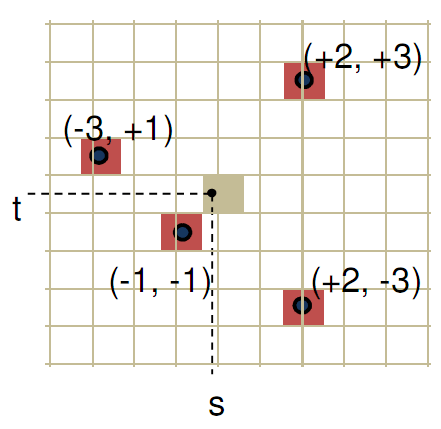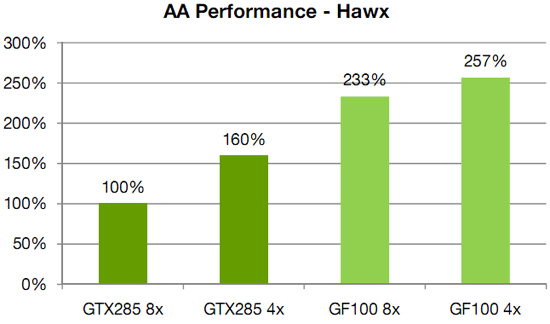Better Image Quality: Jittered Sampling & Faster Anti-Aliasing
As we’ve stated before, the DX11 specification generally leaves NVIDIA’s hands tied. Without capsbits they can’t easily expose additional hardware features beyond what DX11 calls for, and even if they could there’s always the risk of building hardware that almost never gets used, such as AMD’s Tessellator on the 2000-4000 series.
So the bulk of the innovation has to come from something other than offering non-DX11 functionality to developers, and that starts with image quality.
We bring up DX11 here because while it strongly defines what features need to be offered, it says very little about how things work in the backend. The Polymorph Engine is of course one example of this, but there is another case where NVIDIA has done something interesting on the backend: jittered sampling.
Jittered sampling is a long-standing technique used in shadow mapping and various post-processing techniques. In this case, jittered sampling is usually used to create soft shadows from a shadow map – take a random sample of neighboring texels, and from that you can compute a softer shadow edge. The biggest problem with jittered sampling is that it’s computationally expensive and hence its use is limited to where there is enough performance to pay for it.

In DX10.1 and beyond, jittered sampling can be achieved via the Gather4 instruction, which as the name implies is the instruction that gathers the neighboring texels for jittered sampling. Since DX does not specify how this is implemented, NVIDIA implemented it in hardware as a single vector instruction. The alternative is to fetch each texel separately, which is how this would be manually implemented under DX10 and DX9.

NVIDIA’s own benchmarks put the performance advantage of this at roughly 2x over the non-vectorized implementation on the same hardware. The benefit for developers will be that those who implement jittered sampling (or any other technique that can use Gather4) will find it to be a much less expensive technique here than it was on NVIDIA’s previous generation hardware. For gamers, this will mean better image quality through the greater use of jittered sampling.
Meanwhile anti-aliasing performance overall received a significant speed boost. As with AMD, NVIDIA has gone ahead and tweaked their ROPs to reduce the performance hit of 8x MSAA, which on previous-generation GPUs could result in a massive performance drop. In this case NVIDIA has improved the compression efficiency in the ROPs to reduce the hit of 8x MSAA, and also cites the fact that having additional ROPs improves performance by allowing the hardware to better digest smaller primitives that can’t compress well.

NVIDIA's HAWX data - not independently verified
This is something we’re certainly going to be testing once we have the hardware, although we’re still not sold on the idea that the quality improvement from 8x MSAA is worth any performance hit in most situations. There is one situation however where additional MSAA samples do make a stark difference, which we’ll get to next.










115 Comments
View All Comments
dentatus - Monday, January 18, 2010 - link
Absolutely. Really, the GT200/RV700 generation of DX10 cards was inarguably 'won' (i.e most profitable) for AMD/ATI by cards like the HD4850. But the overall performance crown (i.e highest in-generation performance) was won off the back of the GTX295 for nvidia.But I agree with chizow that nvidia has ultimately been "winning" (the performance crown) each generation since the G80.
chizow - Monday, January 18, 2010 - link
Not sure how you can claim AMD "inarguably" won DX10 with 4850 using profits as a metric. How many times did AMD turn a profit since RV770 launched? Zero. They've posted 12 straight quarters of losses last time I checked. Nvidia otoh has turned a profit in many of those quarters and most recently Q3 09 despite not having the fastest GPU on the market.Also, the fundamental problem people don't seem to understand with regard to AMD and Nvidia die size and product distribution is that they overlap completely different market segments. Again, this simply serves as a referendum in the differences in their business models. You may also notice these differences are pretty similar to what AMD sees from Intel on the CPU side of things....
Nvidia GT200 die go into all high-end and mainstream parts like GTX 295, 285, 275, 260 that sell for much higher prices. AMD RV770 die went into 4870, 4850, and 4830. The latter two parts were competing with Nvidia's much cheaper and smaller G92 and G96 parts. You can clearly see that the comparison between die/wafer sizes isn't a valid one.
AMD has learned from this btw, and this time around it looks like they're using different die for their top tier parts (Cypress) and their lower tier parts (Redwood, Cedar) so that they don't have to sell their high-end die at mainstream prices.
Stas - Tuesday, January 19, 2010 - link
[quote]Not sure how you can claim AMD "inarguably" won DX10 with 4850 using profits as a metric. How many times did AMD turn a profit since RV770 launched? Zero. They've posted 12 straight quarters of losses last time I checked. Nvidia otoh has turned a profit in many of those quarters and most recently Q3 09 despite not having the fastest GPU on the market. [/quote]AMD also makes CPUs... they also lost market due to Intel's high end domination... they lost money on ATI... If it wasn't for success of the HD4000 series, AMD would've been in deep shit. Just think before you post.
Calin - Tuesday, January 19, 2010 - link
Hard to make a profit paying the rates of a 5 billion credit - but if you want to take it this way (total profits), why wouldn't we take total income?AMD/ATI:
PERIOD ENDING 26-Sep-09 27-Jun-09 28-Mar-09 27-Dec-08
Total Revenue 1,396,000 1,184,000 1,177,000 1,227,000
Cost of Revenue 811,000 743,000 666,000 1,112,000
Gross Profit 585,000 441,000 511,000 115,000
NVidia
PERIOD ENDING 25-Oct-09 26-Jul-09 26-Apr-09 25-Jan-09
Total Revenue 903,206 776,520 664,231 481,140
Cost of Revenue 511,423 619,797 474,535 339,474
Gross Profit 391,783 156,723 189,696 141,666
Not looking so good for the "winner of the generation", though. As for the die size and product distribution, all I'm looking at is the retail video card offer, and every price bracket I choose have both NVidia and AMD in it.
knutjb - Wednesday, January 20, 2010 - link
You missed my point. I wasn't talking about AMD as a whole I was talking about ATI as a division within AMD. If a company bleeds that much and still survives some part of the company must be making some money and that is the ATI division. ATI is making money. Your macro numbers mean zip.The model ATI is using is putting out competitive cards from a company, AMD, that is bleeding badly. What generation card is easier to sell the new and improved one with more features, useful or not, or the last generation chip?
beck2448 - Tuesday, January 19, 2010 - link
Those numbers are ludicrous. AMD hasn't made a profit in years. ATI's revenue is about 30% of Nvidia's.knutjb - Monday, January 18, 2010 - link
ATI is what has been floating AMD with its profits. ATI has decided to make smaller incremental developmental steps that lower end production costs.Nvidia takes a long time to create a monolithic monster that required massive amounts of capital to develop. They will not recoup this investment off gamers alone because most don't have that much cash to put one of those cards in their machines. It is needed for marketing so they can push lower level cards implying superiority, real or not, they are a heavy marketing company. This chip is directed at their GPU server market and that is where they hope to make their money hoping it can do both really well.
ATI on the other hand by making smaller steps, but at a higher cycle of product development, have focused on the performance/mainstream market. With lower development costs they can turn out new cards that payback development costs back quicker allowing them to put that capital back into new products. Look at the 4890 and 4870. They both share similar architecture but the 4890 is a more refined chip. It was a product that allowed ATI to keep Nvidia reacting to ATI's products.
Nvidia's marketing requires them to have the fastest card on the market. ATI isn't trying to keep the absolute performance crown but hold onto the price/performance crown. Every time they put out a slightly faster card it forces Nvidia to respond. Nvidia recieves lower profits from having to drop card prices. I don't think this chip will be able to function on the 8800 model because AMD/ATI is now on stronger financial footing than they have been in the past couple years and Nvidia being late to market is helping ATI line their pockets cash. The 5000 series is just marginally better, but is better than Nvidia's current offerings.
Will Nvidia release just a single high end card or several tiers of cards to compete across the board? I don't think one card will really help the bottom line over the longer term.
StormyParis - Monday, January 18, 2010 - link
I'm not sure what "winning" means, nor, really what a generation is.you can win on highest performance, highest marketshare, highest profit, best engineering...
a generation may also be adirectX iteration, a chip release cycle (in which case, each manufacturer has its own), a fiscal year...
Anyhoo, I don't really care, as long as i'm regularly getting better, cheaper cards. I'll happily switch back to nVidia
chizow - Monday, January 18, 2010 - link
I clearly defined what I considered a generation, historically the rest of the metrics measured over time (market share, mind share, profits, value-add features, game support) tend to follow suit.For someone like you that doesn't care about who's winning a generation it should be simple enough, buy whatever is best that suits your price:performance requirements when you're ready to buy.
For those who want to make an informed decision once every 12-16 months per generation to avoid those niggling uncertanties and any potential buyer's remorse, they would certainly want to consider both IHV's offerings before making that decision.
Ahmed0 - Monday, January 18, 2010 - link
How can you "win" if your product isnt intended for a meaningful number of customers. Im sure ATi could pull out the biggest, most expensive, hottest and fastest card in the world as well but theres a reason why they dont.Really, the performance crown isnt anything special. The title goes from hand to hand all the time.